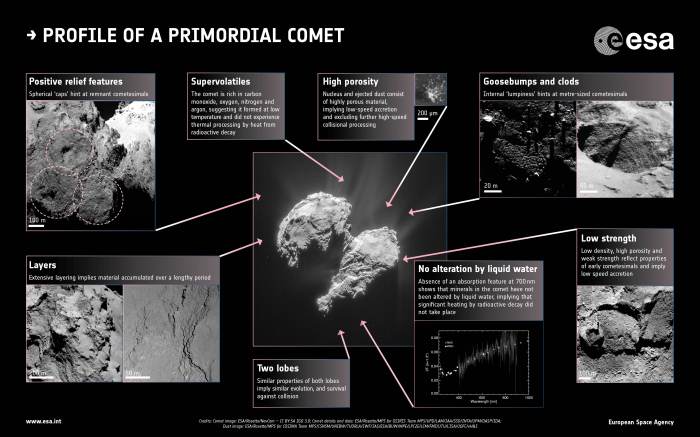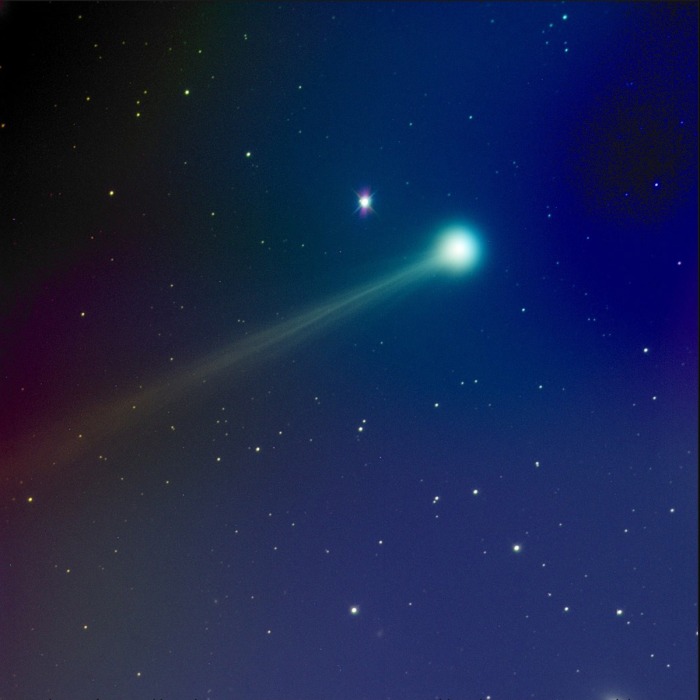Posts Tagged ‘COMETS’
Comet of the century ISON finally visible to naked eye
If we’re lucky, this is just the start of a really spectacular show. Comet ISON dramatically brightened on Wednesday night as it drew ever closer to the sun. It is now visible to the naked eye.
ISON is expected to keep brightening over the next few weeks – and could become a once-in-a-century comet so bright that it can be seen during the daytime. It all depends on whether it survives its close approach to the sun, when the searing heat and intense gravity could tear it to pieces.
Comet ISON, also known as C/2012 S1, was discovered in September last year. It has been journeying towards the inner solar system for at least a million years, having been pulled in from the distant Oort cloud, at the edge of our solar system. On 28 November, it will make its closest approach to the sun, just 1.2 million kilometres above the solar surface.
An army of spacecraft, balloons and ground-based telescopes is poised to pay homage to ISON as its big day approaches.
Read more at http://www.newscientist.com/article/dn24587-comet-of-the-century-ison-finally-visible-to-naked-eye.html#.UoZtXdJ7JBk
Potential ‘comet of the century’ ISON to buzz Mars soon

The Hubble Space Telescope captured this view of Comet ISON, C/2012 S1 (ISON), on May 8 as it streaked between the orbits of Jupiter and Mars at a speed of about 48,000 mph.
Earthlings may be treated to a dazzling celestial display this fall as Comet ISON makes a suicidal plunge toward the sun. But spacecraft exploring Mars are poised to get close-up views of the icy wanderer first.
“Comet ISON is paying a visit to the Red Planet,” astronomer Carey Lisse of the Johns Hopkins University Applied Physics Lab said in a statement. “On Oct 1st, the comet will pass within 0.07 AU from Mars, about six times closer than it will ever come to Earth.”
One AU, or astronomical unit, is the distance between the Earth and sun, about 93 million miles (150 million kilometers). Comet ISON’s Mars flyby, at 0.07 AU, will be about 6.5 million miles (10.4 million km).
Comet ISON may brighten enough for NASA’s Mars rover Curiosity to see it from the surface of the Red Planet. However, Lisse said the best chance for a Martian sighting lies with the space agency’s Mars Reconnaissance Orbiter.
The MRO satellite is equipped with a powerful telescope named HiRISE that is intended to take pictures the Red Planet’s surface. But researchers think the instrument will be capable of turning its gaze into space to detect the comet’s atmosphere and tail.
“The camera is designed for rapid imaging of Mars,” the HiRISE’s telescope’s principal investigator, Alfred McEwen of the University of Arizona, said in a statement. “Our maximum exposure time is limited compared to detectors on other space telescopes. This is a major limitation for imaging comets. Nevertheless, I think we will detect Comet ISON.”
The satellite is set to take observations of the comet on Sept. 29 and Oct. 1 and 2. The observations could help researchers prepare for a comet that is set to fly even closer to Mars in October 2014.
“The science value of observing Comet ISON is hard to predict. We’ve never tried such a thing before,” McEwen said. “However, this is good practice for Comet Siding Spring, which will pass much closer to Mars in 2014.”…
… Read more at http://www.nbcnews.com/science/potential-comet-century-ison-buzz-mars-soon-8C11073465
Video: Comet ISON’s Path Through the Solar System
Dinosaur-killing space rock ‘was a comet’
The space rock that hit Earth 65m years ago and is widely implicated in the end of the dinosaurs was probably a speeding comet, US scientists say.
Researchers in New Hampshire suggest the 180km-wide Chicxulub crater in Mexico was carved out by a smaller object than previously thought.
Many scientists consider a large and relatively slow moving asteroid to have been the likely culprit.
Details were outlined at the 44th Lunar and Planetary Science Conference.
But other researchers were more cautious about the results.
“The overall aim of our project is to better characterise the impactor that produced the crater in the Yucatan peninsula [in Mexico],” Jason Moore, from Dartmouth College in New Hampshire, told BBC News.
The space rock gave rise to a global layer of sediments enriched in the chemical element iridium, in concentrations much higher than naturally occurs; it must have come from outer space.
Extra-terrestrial chemistry
However, in the first part of their work, the team suggests that frequently quoted iridium values are incorrect. Using a comparison with another extraterrestrial element deposited in the impact – osmium – they were able to deduce that the collision deposited less debris than has previously been supposed …..
…. Read more at: http://www.bbc.co.uk/news/science-environment-21709229
Read also:
Zircon U-Pb Geochronology Links the End-Triassic Extinction with the Central Atlantic Magmatic Province
Terrence J. Blackburn et al
The end-Triassic extinction is characterized by major losses in both terrestrial and marine diversity, setting the stage for dinosaurs to dominate Earth for the next 136 million years. Despite the approximate coincidence between this extinction and flood basalt volcanism, existing geochronologic dates have insufficient resolution to confirm eruptive rates required to induce major climate perturbations. Here, we present new zircon U-Pb geochronologic constraints on the age and duration of flood basalt volcanism within the Central Atlantic Magmatic Province. This chronology demonstrates synchroneity between the earliest volcanism and extinction, tests and corroborates the existing astrochronologic time scale, and shows that the release of magma and associated atmospheric flux occurred in four pulses over ~600,000 years, indicating expansive volcanism even as the biologic recovery was under way….
… http://www.sciencemag.org/content/early/2013/03/20/science.1234204
Herschel Serves up Solar Systems with Extra Comets
This artist’s impression shows the orbits of planets and comets around the star 61 Vir, superimposed on a view from the Herschel Space Telescope.
The line drawing gives a schematic representation of the location and orientation of the star, planets and outer debris disk of comets, albeit not to scale. The black oval outline sketched onto the Herschel data represents the innermost boundary of the debris disk; the approximate location of the outermost boundary is represented by the outer set of dashed lines. It is not possible to identify the central star due to smearing of the Herschel data.
The two planets around 61 Vir have masses between 5 and 18 Earth masses and are both located within 0.22 astronomical units of the central star (an astronomical unit is the distance between Earth and the sun). The vast debris disk extends from approximately 30 to 100 astronomical units
Read more: www.nasa.gov





